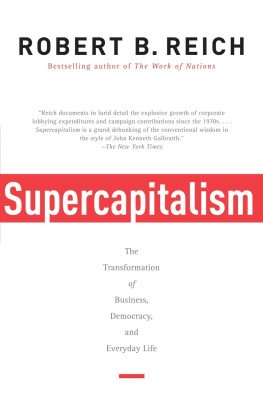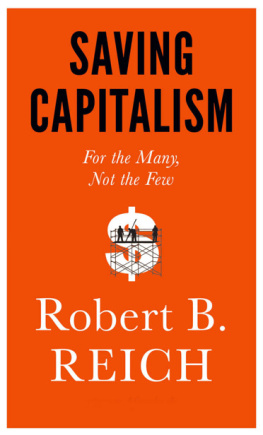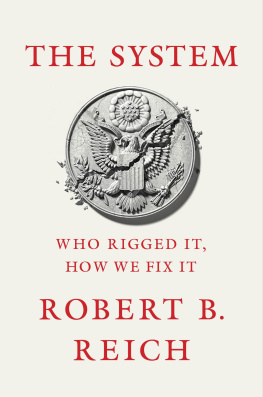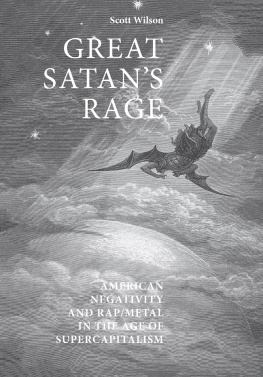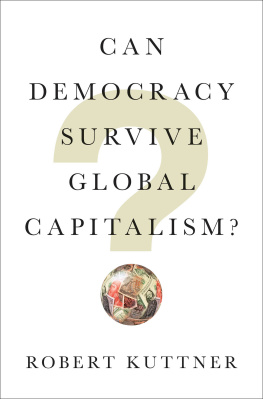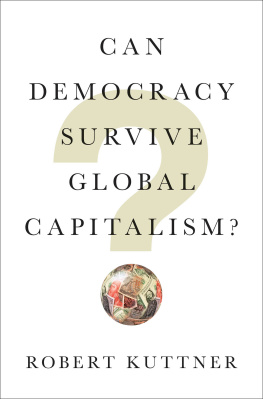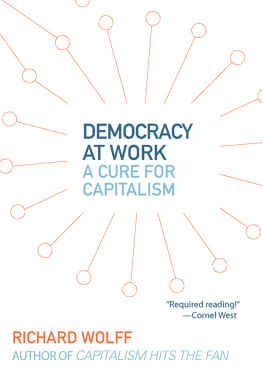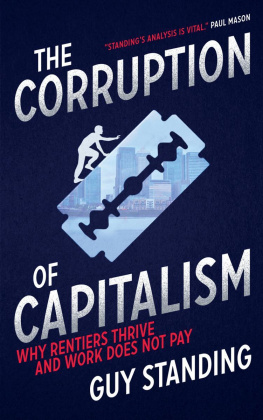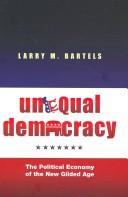sorry something went wrong loading your content. Check the table of contents or try paging forward. Or contact us at support@bookshout.com
sorry something went wrong loading your content. Check the table of contents or try paging forward. Or contact us at support@bookshout.com
sorry something went wrong loading your content. Check the table of contents or try paging forward. Or contact us at support@bookshout.com
sorry something went wrong loading your content. Check the table of contents or try paging forward. Or contact us at support@bookshout.com
CHAPTER ONE
T HE N OT Q UITE G OLDEN A GE
R OUGHLY BETWEEN 1945 and 1975, America struck a remarkable accommodation between capitalism and democracy. It combined a hugely productive economic system with a broadly responsive and widely admired political system. America in those years achieved its highest degree of income equality (since measurements have been available). It generated a larger proportion of good-paying jobs than before or since, and more economic security than ever for more of its people. Perhaps not coincidentally, in those years Americans also expressed high confidence in democracy and trust in government, both of which sharply declined in subsequent years. That singular success and that powerful promise extended the moral authority of the American system throughout the world. In contrast to Soviet communism, America became an exemplar of both political freedom and suburban middle-class affluence.
The economy was based on mass production. Mass production was profitable because a large middle class had enough money to purchase what could be mass-produced. The middle class had the money because the profits from mass production were divided up between the giant corporations and their suppliers, retailers, and employees. The bargaining power of these latter groups was enhanced and enforced by government action. Almost a third of the workforce belonged to a labor union. Economic benefits were also spread across the nationto farmers, veterans, smaller towns, and small businessesthrough regulation (of railroads, telephones, utilities, and energy supplies) and subsidy (price supports, highways, federal loans). Thus did democracy offset the economic power of large-scale production and widely disperse its benefits.
But it was not quite a golden age. Women and minorities still struggled for political equality and economic opportunity. Much of the nations poverty was hidden away in rural hollows or black ghettos. Foreign policy, ostensibly shaped by the perceived threat of Soviet communism, all too frequently pandered to the needs of large American firms for cheap resources abroad, such as bananas, tin, and oil. Civil liberties were imperiled during Senator Joe McCarthys anti-communist witch hunt. Much of American life was monotonous, conformist, and deadly dull. And yet for all its shortcomings, democratic capitalism seemed to be working remarkably well, and on the way to working even better.
In order to understand what happened to the Not Quite Golden Age, we first need to understand how it came about.
T HE EVOLUTION began as the nineteenth century ended, when large corporations posed a profound challenge to American democracy. They brought a new level of prosperity to the nation but also sweatshops, child labor, and unsafe working conditions, and they monopolized whole industries. The unprecedented economic power of these giant companies made them politically unaccountable. America groped for a way to respond.
It started with outsized personalities whose footprints are still visibleJ. P. Morgan, a bankers son who sold stocks for the railroads, engineered a huge rail combination, and became a wealthy financier (J. P. Morgan and Sons, which evolved into todays Morgan Stanley); Andrew Carnegie, who began as a telephone clerk, rose to the presidency of the Pennsylvania Railroad, and then made a fortune as a steel magnate (Carnegie Steel); John D. Rockefeller, who started as a bookkeeper in Cleveland, bought his first oil refinery in 1862, cornered the oil market in the 1890s with his Standard Oil Company (whose descendant is ExxonMobil), and then moved into coal, iron, shipping, copper, and banking (Chase Manhattan); and, subsequently, Henry Ford.
With these men and others like them flowed a stream of new inventionssteam engines, railway locomotives, the telegraph, electric turbines, internal combustion engines, and iron and steel machinery with interchangeable partsthat allowed all sorts of things to be made and shipped in very large volume. Costs could be spread over so many units that each single one was cheap to produce. Procter & Gamble devised a new machine for mass-producing Ivory soap. Diamond Match used a machine that made and boxed matches by the billions. A cigarette-making machine invented in 1881 was so productive that just fifteen of them satisfied Americas annual demand for cigarettes. Standard Oil, American Sugar Refining, International Harvester, and Carnegie Steel, among others, gained unprecedented efficiencies through giant furnaces, whirling centrifuges, converters, and rolling and finishing equipment.
Productivity surged. While the typical American worker in the early 1800s had produced a tiny. 3 percent more each year (seeding and harvesting crops, logging, fishing, or applying his craft with hand tools), by the last decades of the century his productivity was rising at six times that rate. Railroad and telegraph networks expanded in tandem. Fast, regular, and reliable transportation and communication brought raw materials from far corners of the country into factories and sent finished goods out to wholesalers and retailers all over the nation.
An economic revolution on this scale inevitably had large social consequence. Supply outran demand, leading to a severe depression that jolted much of Europe and America in 1873. Another depression in the summer of 1893 impoverished thousands of farmers, closed banks, and left more than a quarter of Americas unskilled urban workforce unemployed. A growing chorus of socialists in Europe and America proclaimed the imminent collapse of capitalism. A swelling cadre of western populists in deepening debt to eastern bankers demanded that currencies be converted from gold to silver. With silver far more abundant than gold, this would inflate currency values and thereby shrink the debts. Manufacturers on both sides of the Atlantic wanted higher tariffs to protect themselves from foreign imports. (Only Britain, whose advanced manufacturers were the primary beneficiaries of free trade, declined to raise its tariffs, resulting in what were seen there as German and American economic invasions.)
Hundreds of thousands of people moved from farms to factories. In 1870, fewer than 8 percent of Americas adult population worked in a mill and only one in five lived in a place with 8,000 or more inhabitants; a half century later, almost a third were in factories and almost a half lived in cities. During this tumultuous span of time, New York Citys population swelled fourfold; Chicago became ten times its former size. In the 1870s, 280,000 immigrants entered the United States each year. In the 1880s, 5.5 million came; in the 1890s, another 4 million. By the first decade of the twentieth century, the flow of immigrants, most of them destitute when they arrived, rose to a million a year. According to a 1908 government study, almost three-fifths of the wage earners in principal branches of American industry had been born abroad. Immigrants then constituted a higher percentage of the total American workforce than they would a hundred years hence.
As America and every other manufacturing nation began scouring more backward regions of the globe for potential markets, the term imperialism entered common speech. Teddy Roosevelt asserted Americas imperial destiny in Latin America. Territorial expansion, explained an official of the United States State Department in 1900, is but the by-product of the expansion of commerce. But the world war Hobson feared would occur before enough citizens had the wherewithal to buy a substantial portion of what they produced.
Next page
